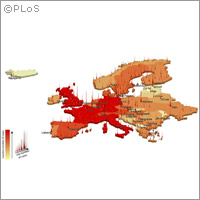European scientists develop model on potential flu pandemic
European researchers have constructed a model that predicts how an emerging pandemic influenza might spread across the globe by air travel. The study, 'Modelling the Worldwide Spread of Pandemic Influenza: Baseline Case and Containment Intervention', was partly funded by the EU Sixth Framework Programme (FP6) and the US National Science Foundation (NSF). The model is the world's largest-scale epidemic simulation of its kind and appears in the January issue of the journal PLoS Medicine. Although H5N1 avian influenza, or bird flu as it is commonly called, has not yet resulted in a pandemic because of the virus' inability to spread among humans, public health officials are concerned that a human flu strain could be triggered by the H5N1 virus. 'The threat of a pandemic is pushing the international community to discuss scenario analysis and develop adequate preparedness plans,' said Vittoria Colizza, on the researchers in involved in the project. 'This calls for the need to understand the possible propagation of a pandemic, in order to devise and test appropriate intervention strategies to contain and mitigate its evolution and impact on the population.' The research team developed a mathematical model basing themselves on passenger-flow data from the International Air Transport Association, census information from more than 3,000 urban centres and 220 countries worldwide. Using advanced computational tools, the team was able to simulate how an influenza pandemic would spread both over time and geographically. It also provided forecasted scenarios. One of the scenarios the model predicts is a flu virus, originating in Hanoi, Vietnam, with a reproductive number of 1.1 (a measure of how many people are infected on average by an infectious person) poses only a very mild global threat. Increase that number to 1.5 and the flu potentially could infect half the population in more than 100 countries. Intervention measures would then be necessary. The researchers learnt two lessons from their study. The first was that strict travel restrictions would do little, to prevent the flu from spreading throughout the globe. The second was that the use of antiviral drugs would significantly thwart a global flu outbreak if every country in the world had a large enough drug stockpile to treat 5 to 10% of their populations. The study then focused on realistic scenarios in which antiviral resources were not equally distributed, with a higher concentration in wealthy countries. Two different strategies were compared; a selfish strategy in which each country relied on its own supplies, as opposed to a cooperative approach in which prepared countries would donate part of their resources for global use. 'Surprisingly the cooperative strategy is shown to be more effective in delaying the pandemic evolution and mitigating its impact on the population of both donor and recipient countries,' Alessandro Vespignani, Professor of Informatics at Indiana University. The research concluded by being in favour of the cooperative strategy of sharing resources, which could be organised and managed by the World Health Organisation, as this would be the most efficient way of dealing with an emerging influenza pandemic whilst waiting for vaccine development, according to the authors. The research was carried out by the Complex Networks Collaboratory, CX-NETS, a virtual collaboration of research groups that pursue the same research agenda in complex networks and systems, epidemic modelling and non-equilibrium statistical physics.



